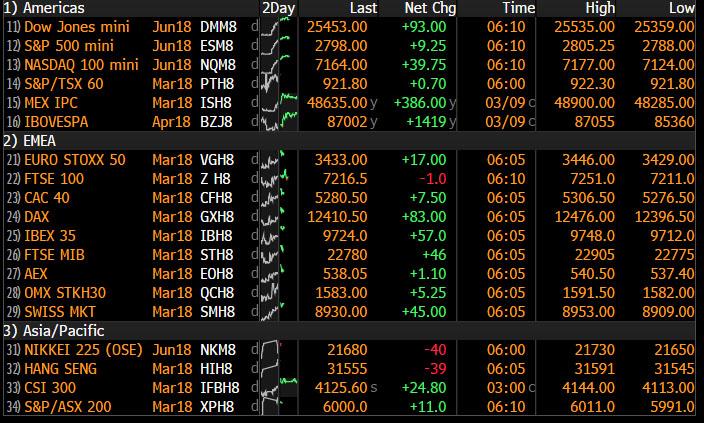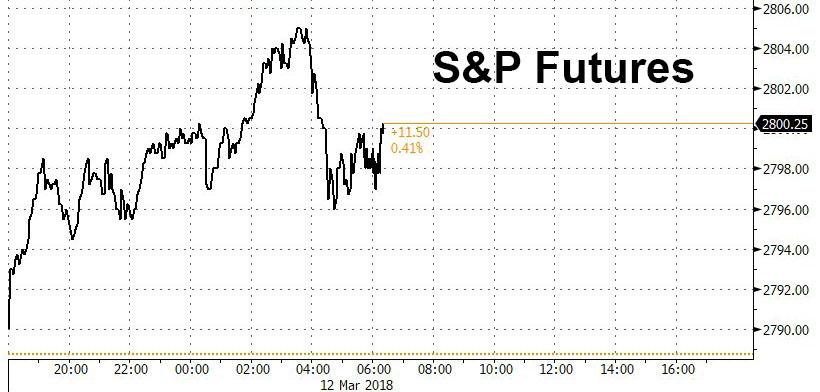The “goldilocks” mood that was unleashed after Friday’s jobs report (high growth, low inflation) has spread around the globe, sending Asian and European markets higher as trade-war concerns took a back seat to economic optimism. The dollar slipped and Treasuries held steady even as the US Treasury prepares to sell $145 billion in debt today (including both 3Y and 10Y Paper), while most commodities fell.

“Friday’s U.S. employment data was about as perfect a set of figures as you can get from a policy maker’s point of view. The increase in jobs was nothing short of amazing,” said ACLS Global’s Marshall Gittler. “In other words, it was a ‘Goldilocks’ report: not too hot, not too cold, just right.”
“Our customers are still bullish,” Chris Brankin, chief executive officer at TD Ameritrade Singapore, told Bloomberg TV. “You saw the jobs report last Friday, which was a perfect scenario — you had an uptick in wages, but not too much. Investors have taken that opportunity to buy the market dips and we look for the bull market to continue.”
European shares shot up across the board, following their Asian counterparts while emerging market currencies strengthened as investors bought up so-called riskier assets and sold safe-haven securities such as gold and government bonds. After the S&P surged 1.7% on Friday – its second best day of the year – S&P futures have continued to levitate overnight, and are back above 2,800 and fast approaching their late January all-time highs of 2,883.

The Stoxx Europe 600 Index rose for a sixth day, poised for the longest winning streak since October as utility companies set the pace following a bid by EON for RWE’s Innogy. Germany’s DAX led gains in Europe, rising 0.9% while MSCI’s world equity index hit a two-week high. Concerns over tariffs have been weighing on European stocks, with the main European stock index hitting a seven-month low at the start of the month. It has recovered somewhat from that trough to rise 0.3% on Monday.
Earlier, the MSCI Asia-Pacific ex-Japan Index climbed 1.4 percent, poised for a third session of gains. South Korea rose 1%, while Australia’s main index added 0.7 percent, boosted by mining shares on news that Australia could be exempt from new U.S. trade tariffs on steel and aluminum imports. Hong Kong stocks climbed with other Asian markets after Friday’s U.S. jobs report showed an increase in hiring without rapid wage gains: the Hang Seng gained 1.9%, its third day of gains, and the highest since Feb. 5. The Hang Seng China Enterprises Index jumped 2.1%, also up for third session, while on the mainland, the Shanghai Composite added 0.6% and the ChiNext Index of smaller shares rose 1.4%.
In global FX, investors shifted their focus to politics sending the Aussie higher after the country secured an exemption from U.S. tariffs on steel and aluminum and as politicians from a wide range of other countries joined the chorus to also be on the list of Trump tariff exemptions. Meanwhile, as noted last night, the yen jumped after Japan’s Finance Minister Taro Aso refused to step down despite news that his name and that of Prime Minister Shinzo Abe were removed from documents connected with a land-sale scandal, creating uncertainty around the future of Abenomics. The advance, however, was pared after Aso said he won’t resign.
Commenting on the USD/JPY, Masashi Murata, a currency strategist at Brown Brothers Harriman in Tokyo said that “The theme for 2018 is the risk of the dollar-yen breaking 100,” adding that the yen above that level “wouldn’t look excessive from the perspective of its fundamentals.” Separately, Goldman analysts said that the BOJ and the Japanese government have “very limited” policy options for reining in yen appreciation, and they are most likely to take a wait-and-see stance until the latest round of gains comes to an end.
Investors had trimmed holdings of yen last week on news U.S. President Donald Trump was prepared to meet with North Korean leader Kim Jong Un, a potential breakthrough in nuclear tensions in the region. U.S. officials on Sunday defended Trump’s decision, saying the move was not just for show and not a gift to Pyongyang. “Now the U.S. is back to Goldilocks at least for now, the tariffs are less severe, and Kim and Trump are to meet,” said Shane Oliver, Sydney-based chief economist at AMP. “We still expect more volatility this year as many of these issues have further go run, but the broad trend in shares likely remains up.”
The dollar edged lower a second day as markets digested Friday’s jobs report, which kept stocks in Asia and Europe underpinned.
In geopolitical news, North Korea reportedly wants a peace treaty and to build ties with US, while its leader Kim also wants a US embassy in Pyongyang.
In Brexit news, UK and EU companies reportedly could face an additional GBP 58bln in annual costs in the event of a no-deal Brexit. Meanwhile, UK consumer spending suffered its weakest start to the year since 2012, according to data compiled by Visa.
In rates, the yield on 10-year Treasuries climbed less than one basis point to 2.90%, the highest in more than two weeks. Germany’s 10-year yield dipped one basis point to 0.64%, while Britain’s 10-year Gilt rose less than one basis point to 1.493 percent.
Today, US rates traders will have a very busy day with the US set to sell $145BN in sells 3- and 6-month bills, as well as 3-year notes and 10-year notes reopening. Big concessions into the auctions are expected to help soak up the massive supply. As a reminder the last time that the market faced a 3y and 10y auction on the same day last year Treasuries sold off following weak demand in the latter auction.
Oil prices pared back gains seen on Friday with WTI (-0.5%) and Brent (-0.6%) seen lower amid concerns of rising US output looming in the market despite a slowdown in rig drilling activity recorded at the back end of last week. In the metals complex, following the US steel and aluminum tariffs, Chinese iron ore future fell for a 3rd straight session hitting near four-month lows closing down 2.6%. The steelmaking raw materials are under pressure from softer demand and high product inventories held by trading companies. The WSJ reported that OPEC is reported to be divided regarding views on the right price of oil with Iran said to prefer USD 60/bbl, while Saudi Arabia would prefer prices to be at USD 70/bbl. There were also reports that Iran Oil Minister Zanganeh stated that OPEC could agree in June to begin relaxing oil output cuts for 2019.









Leave A Comment